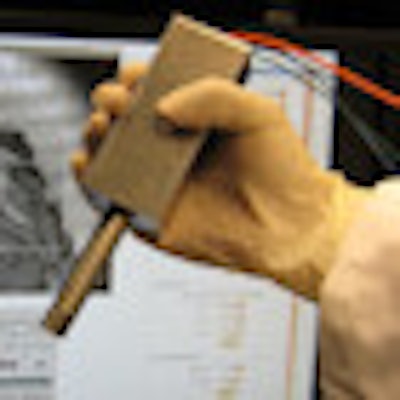
Bioengineers at the University of Texas (UT) at Austin have developed a portable, miniature microscope designed to improve the ability to detect early-stage oral cancer and improve surgical margin assessments, according to a paper published today in the Journal of Micromechanics and Microengineering.
 Researchers from the University of Texas at Austin have developed a portable, miniature microscope to improve oral cancer diagnoses and surgical margin assessments. Image courtesy of University of Texas at Austin.
Researchers from the University of Texas at Austin have developed a portable, miniature microscope to improve oral cancer diagnoses and surgical margin assessments. Image courtesy of University of Texas at Austin.
The probe, which is 20 cm long and 1 cm wide at its tip, is a miniaturized version of a confocal microscope. It uses a laser to illuminate areas of the sample and can view beneath the surface of tissue up to 500 microns deep, creating full 3D images.
It can also take a series of images and layer them on top of each other, yielding a larger field of view (JMM, April 27, 2012).
"This device is based on confocal imaging, a concept that has been around for decades," John X. J. Zhang, PhD, lead author on the study, told DrBicuspid.com. "But moving it into small form factors, there are critical issues to consider, such as how to make the dedicated optical components smaller while still meeting the necessary functionalities. But this is what my group specializes in: manipulating photons at microscales."
The magic of micromirrors
The key component of the probe is a micromirror. Micromirrors have previously been used in barcode scanners and fiber optic switches and are controlled by a microelectromechanical system (MEMS), allowing the laser beam to scan an area in a programmed fashion.
"This is the first time we have demonstrated this using different scanning patterns that can be controlled via a computer," Dr. Zhang said. "This means we can balance field-of-view and resolution through efficient algorithms for each image acquired. We can then stitch each individual image together -- something called 'mosaic imaging' -- to create an even larger field-of-view."
The low cost and ease of fabrication of micromirrors, along with their easy integration into electronic systems for versatile imaging operations, make them an indispensable component of the probe, Zhang and his colleagues noted.
For this study, they compared a prototype of the miniature confocal imaging probe with a conventional -- and much more expensive -- desktop confocal microscope at the University of Texas Health Science Center at San Antonio (UTHSCSA). Using each system, they scanned a variety of oral cancer tissue samples, including neurofibroma, giant cell fibroma, and epithelial ossifying fibroma, and found that the handheld probe showed "good accordance" with control images acquired from the laboratory microscope, the researchers noted.
"The MEMS scanner-based handheld confocal imaging probe shows great promise as a potential clinical tool for oral cancer diagnosis and treatment," they concluded.
Commercialization efforts
"These are promising results," Zhang said. "This device offers a compact footprint, low-cost approach, with versatile scanning motion. Our next step will be to do real-time diagnosis. That is what most clinicians are passionate about."
Once it is commercialized, the probe could be used by physicians and surgeons to diagnose oral cancer in real-time or as a surgical guidance tool, he added.
"In the short term, our collaborators are very passionate about using this in oral cancer surgery," said Ting Shen, PhD, CEO of NanoLite Systems, which is working with Dr. Zhang's group to commercialize the device.
"Once a patient is diagnosed with oral cancer, surgeons will remove soft tissue and even some of the bone. We want to make sure they can create the correct surgical margins, which is very important for the quality of life for the patient."
It could also be used in dental offices to screen for early-stage cancer cells, Zhang noted.
"Our goal is to ultimately deploy this system to hospitals, medical centers, and dental offices with larger volumes of customer groups," Shen said.
Zhang's group is collaborating with multiple institutions in the development and testing of the probe, including UTHSCSA, UT Southwestern Medical Center in Dallas, and M.D. Anderson Cancer Center in Houston. These same facilities will be involved in the human clinical trials needed for regulatory approval.
Shen anticipates the device could be on the market in two to three years, depending on when they receive U.S. Food and Drug Administration 510(k) clearance. While the initial cost may be a bit high for a dental office -- Shen estimates between $60,000 and $80,000, compared to $100,000- $500,000 for a conventional confocal microscope -- she and Zhang are confident the device will become an important tool for medical and dental practitioners.
"The challenge is, if dentists don't have a lot of patients they're doing annual exams on and they don't find a lot of suspicious lesions, they might not find the value proposition in this," Shen said. "But as the technology matures, we can establish the value proposition and take oral cancer diagnostics to the next level."



















